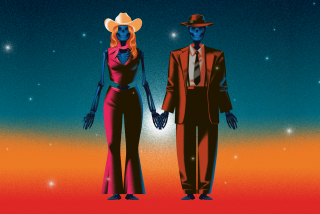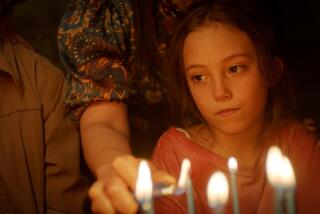Indie Focus: Fictional yet real lives on ‘Putty Hill’
Taking place on the edges of Baltimore, in neighborhoods at once rural and urban, leafy and developed, “Putty Hill” unfolds to become an absorbing look at loss, a portrait of grief and the emotional heft of carrying on in the face of fresh absence. Family and friends assemble for the funeral of one of their own who died from a drug overdose, and as they go about their routines many are asked interview-style questions from off-screen by the film’s director, Matt Porterfield.
Though this may sound like the stuff of a documentary, “Putty Hill” is a work of fiction, albeit one that, in the words of producer Jordan Mintzer, is “a story invented for the screen but true to life.” The film, which opened in Los Angeles on Friday, had its world premiere at the 2010 Berlin Film Festival, with its North American premiere at last year’s South by Southwest Film Festival. It screened locally as part of the AFI Fest last fall and recently won the first Heterodox Award from the Cinema Eye Honors, a prize given specifically to a fiction film that uses techniques of documentary filmmaking.
“If there’s an independent cinema, this movie is it, and if there’s a new director, here he is,” wrote the New Yorker’s Richard Brody of “Putty Hill” and Porterfield.
Yet the film initially came about as a save and a scramble more than the product of a grand plan. After the successful festival run of Porterfield’s 2006 film “Hamilton,” he began working on a project to be called “Metal Gods” about Baltimore kids who are into heavy metal music. Working from a conventional script, he cast the film with unknowns and nonprofessionals, found locations and set a start date. Then, as 2009 progressed, he realized there was no way he was going to raise all the money he needed and instead reconceived what he was working on to fit what he had.
“Putty Hill” emerged from Porterfield’s desire to hold on to the cast and locations he had already carefully assembled, so he devised a five-page treatment to give the new story a backbone. (The treatment is available on the film’s website.) That same sense of speed and fluidity continued throughout the film’s 12-day shoot, with an edit assembled only a couple of months later and the film’s Berlin premiere barely two months after that.
“I had all this cast, I’d been holding auditions, and there were a number of people I wanted to see on screen. I basically built the scenario around them,” said Porterfield recently by phone from Baltimore. The sections of the northeast part of the city seen in the film are the same as where the 33-year-old Porterfield grew up and still lives.
“Formally, it followed the structure of a screen test we’d done that April,” he added, “where we interviewed our two potential leads and tied these talking-head interviews into a fictive narrative scene. We liked the formal device so much that it seemed like something we could try in long form, and that’s where the idea for ‘Putty Hill’ came from.”
Though Porterfield did not initially intend to inject himself into the story, his off-screen presence becomes at times a powerful one, gently probing his actors by treating them as subjects of a fictionalized documentary.
“It’s sort of a self-conscious way to acknowledge the relationship between the filmmaker and the subject,” said Porterfield of the film’s interview vignettes. “I think there’s something in the relationship between the off-screen voice and the character on-screen, acknowledging the fiction but also subsequently reaching a kind of truth where we can see people as they want to see themselves, as they project themselves into the world.
“In ‘Putty Hill’ we see people the way they want to be seen. I like that about the film. I think it wouldn’t quite work if we hadn’t combined the interviews with the fiction scenes the way we did.”
Regarding the look of the film, shot on digital video and fully exploring the format’s ability to peer deeply into dimly lighted spaces, cinematographer Jeremy Saulnier added, “Half of it truly is an aesthetic choice; we like naturalism, low contrast, dark and moody. But we also didn’t really have the capacity to bring up the interiors to what some would call a proper exposure level.”
In conversation, Porterfield is quiet but confident, dropping references to such filmmakers as Robert Bresson and Pedro Costa that might score points on the festival circuit but also draw blank looks from more mainstream moviegoers. Like other contemporary American independent filmmakers such as Kelly Reichardt and Ramin Bahrani, Porterfield has been able to partly shield himself from crasser commercial concerns by working within academia. As a day job he teaches film courses at Johns Hopkins University.
While “Putty Hill” has received its share of critical accolades, the film has been declared “poverty porn” by some, the argument being that in wading into these real environments to make fictions of the lives of real people, Porterfield has exploited them. While acknowledging that he may have brought some of the disapproval on himself by way of his own comments criticizing the portrayal of the Ozarks in recent indie darling “Winter’s Bone,” Porterfield seems genuinely stung by those who question the ethical motives of “Putty Hill.”
“I just feel like critics or audiences that respond to the film as ‘poverty tourism’ or ‘poverty porn’ are calling themselves out. I look at the movie and I see myself,” Porterfield responded. “I still live in this neighborhood, in a house I grew up in with my dad. These are my people. I look at the film as myself on-screen.
“It’s a shame that normal people aren’t seen in movies more, that we’re so used to seeing versions of people’s lives in major metropolises like New York or Southern California that we can’t realize real people when we see them. I’m always struck when people look at the film as this study of this impoverished class. This is a middle-class film. To me, you can make a film anywhere.”
More to Read
The biggest entertainment stories
Get our big stories about Hollywood, film, television, music, arts, culture and more right in your inbox as soon as they publish.
You may occasionally receive promotional content from the Los Angeles Times.







